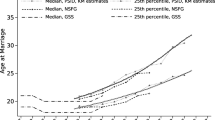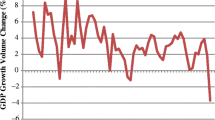Abstract
This paper uses data from the 1997 cohort of National Longitudinal Study of Youth to examine racial differences in the first coresidential union experiences of young adult women in early adulthood. Young adults increasingly choose to delay marriage and opt to live with a significant other during their early adulthood years. Results from early studies of racial differences in relationship formation reported that Blacks had a higher probability that their first coresidential relationship was a cohabiting one despite a lower overall probability of being in a cohabiting relationship. Little is known about whether and how these early relationship experiences changed in the ensuing years, and the underlying causes for the racial differences in young adult union formation behaviors remain poorly understood. I use multivariate analyzes and decomposition techniques on a recent cohort of young women, between the ages of 12 and 18 in 1997, to examine the role of family background characteristics, sexual history, and economic and educational measures on the probability of an early coresidential relationship. I conclude with a brief examination of the fertility patterns surrounding that first union and the state of the union by age 24.

Similar content being viewed by others
References
Addo F, Sassler S. Financial arrangements and relationship quality in low-income couples. Fam Relat. 2010;59:408–23.
Akerlof GA, Yellen JL, Katz ML. An analysis of out-of-wedlock childbearing in the United States. Q J Econ. 1996;111:277–317.
Amato P. The impact of family formation change on the cognitive, social, and emotional well-being of the next generation. Futur Child. 2005;15:75–96.
Amato PR, Landale NS, Havasevich-Brooks TC, Booth A, Eggebeen DJ, Schoen R, et al. Precursors of young women’s family formation pathways. J Marriage Fam. 2008;70:1271–1286.
Arnett JJ. Emerging adulthood: The winding road from the late teens through the twenties. New York: Oxford; 2004.
Brown SL. Family structure and child well-being: the significance of parental cohabitation. J Marriage Fam. 2004;66:351–67.
Brown C, Kesselring R. Declining marriage ratios of young Black women: testing alternative economic hypotheses. Rev Black Polit Econ. 2006; 27–44.
Bumpass L, Sweet J. National estimates of cohabitation. Demography. 1989;26:615–25.
Carlson M, McLanahan S, England P. Union Formation in Fragile Families. Demography. 2004;41:237–61.
Cherlin A. The deinstitutionalization of American marriage. J Marriage Fam. 2004;66:848–61.
Edin K. What do low-income single mothers say about marriage? Soc Probl. 2000;47:112–33.
Edin K, Kefalas M. Promises I can keep: Why poor women put motherhood before marriage. Berkeley: University of California Press; 2005.
Elder GH. The life course as developmental theory. Child Dev. 1998;69:1–12.
Furstenberg Jr FF, Kennedy S, McLoyd V, Rumbaut RG, Settersten Jr RA. Growing up is harder to do. Contexts. 2004;3:33–41.
Gibson-Davis C. Mother but not wives: The increasing lag between nonmarital births and marriage. J Marriage Fam. 2011;73:264–78.
Goldin C, Katz LF. The power of the pill: oral contraceptives and women’s career and marriage decisions. J Polit Econ. 2002;110:730–69.
Kennedy S, Bumpass L. Cohabitation and children’s living arrangements: New estimates from the United States. Demogr Res. 2008;19:1663–92.
Landale NS, Schoen R, Daniels K. Early family formation among White, Black, and Mexican American women. J Fam Issues. 2010;31:445–74.
Landale NS, Oropesa RS. Hispanic families: Stability and change. Annu Rev Sociol. 2007;33:381–405.
Lehrer E. Religion as a determinant of entry into cohabitation and marriage. In: Waite LJ, Bachrach C, editors. Ties That Bind: Perspectives on marriage and cohabitation. New York: Aldine de Gruyter; 2000. p. 227–52.
Lichter DT. Childbearing among cohabiting women: Race, pregnancy, and union transitions. In: Booth A, Brown SL, Landale NS, Manning WD, McHale SM, editors. Early Adulthood in a Family Context. New York: Springer; 2012. p. 209–20.
Lichter DT, McLaughlin DK, Kephart G, Landry DJ. Race the retreat from marriage: A shortage of marriageable men? Am Sociol Rev. 1992;57:781–99.
Lichter DT, Turner RN, Sassler S. National estimates of the rise in serial cohabitation. Soc Sci Res. 2009;39:754–65.
Lichter DT, Qian Z, Mellott LM. Marriage or dissolution? Union Transitions among poor cohabiting women. Demography. 2006;43:223–40.
Light A. Gender differences in the marriage and cohabitation income premium. Demography. 2004;41:263–84.
Martin S. Trends in marital dissolution by women’s education in the United States. Demogr Res. 2006;15:537–60.
McLanahan S, Percheski C. Family structure and the reproduction of inequalities. Annu Rev Sociol. 2008;34:257–76.
McLanahan S, Sandefur G. Growing Up With a Single Parent: What Hurts, What Helps. Cambridge: Harvard University Press; 1994.
Olsen RJ, Farkas G. The effect of economic opportunity and family background on adolescent cohabitation and childbearing among low-income Blacks. J Labor Econ. 1990;8:341–62.
Raley RK. A shortage of marriageable men? A note on the role of cohabitation in Black-white differences in marriage rates. Am Sociol Rev. 1996;61:973–83.
Raphael S. Early incarceration spells and the transition to adulthood. In: Danziger S, Rouse C, editors. The price of independence: The economics of adulthood. New York: Russell Sage; 2007. p. 278–305.
Royston P. ICE: STATA module for multiple imputation of missing values (Rev. 11, Statistical Software Components S446602). Boston: Boston College Department of Economics; 2006.
Sassler S. The process of entering cohabiting unions. J Marriage Fam. 2004;66:491–505.
Sassler S. Partnering across the life course: sex, relationships, and mate selection. J Marriage Fam. 2010;72:557–75.
Schoen R, Landale NS, Daniels K. Family transitions in young adulthood. Demography. 2007;44:807–20.
Sigle-Rushton W, McLanahan S. The living arrangements of new unmarried mothers. Demography. 2002;39:415–33.
Smock PJ, Manning WD, Porter M. Everything’s there except money: how money shapes decisions to marry among cohabitors. J Marriage Fam. 2005;67:680–96.
Stevenson B, Wolfers J. Marriage and divorce: changes and their driving forces. J Econ Perspect. 2007;21:27–52.
US Census. 2011. http://www.census.gov/population/www/socdemo/hh-fam.html#history.
Waller M, McLanahan S. “His” and “her” marriage expectations: Determinants and consequences. J Marriage Fam. 2005;67:53–67.
Williams K, Sassler S, Frech A, Addo F, Cooksey E. Nonmarital Childbearing, Union History, and Women’s Health at Midlife. Am Sociol Rev. 2011;76:465–86.
Williams K, Sassler S, Nicholson L. For better or for worse? The consequences of marriage and cohabitation for single mothers. Social Forces. 2008;86:1481–511.
Wilson WJ. The Truly Disadvantaged: The inner city, the underclass, and public policy. Chicago: University of Chicago Press; 1987.
Author information
Authors and Affiliations
Corresponding author
Additional information
The author would like to thank Sharon Sassler, Daniel T. Lichter, Samuel Myers, and the participants of the Invisible Women Conference at Bennett College for helpful discussion and comments on previous drafts.
Appendix A
Appendix A
About this article
Cite this article
Addo, F.R. Ethnoracial Differences in Early Union Experiences Among Young Adult Women. Rev Black Polit Econ 39, 427–444 (2012). https://doi.org/10.1007/s12114-012-9138-2
Published:
Issue Date:
DOI: https://doi.org/10.1007/s12114-012-9138-2




